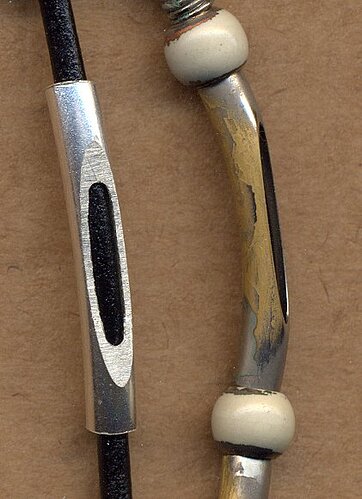Dear Terri Ann,
You have already received some good suggestions but if it is not too
late I’ll add my 2 cents.
First of all, your big problem seemed to be burning your fingers
because of the machine-generated heat. My first response to this -
You are not making very many of these pieces so why use a machine at
all? If you had to make a hundred of them or a thousand, OK, but for
only ten it isn’t so hard to do it by hand.
Before getting to the specifics, I’d say that we all need to be
careful about accomodating to machinery. That is, we spend a lot of
time and energy trying to cope with the heat, the expense, the
dangers, the dust, the noise etc etc that machines bring along with
their seductive speed and power. It’s always worth a bit of time to
evaluate whether they are really needed for a particular job,
whether they are worth the risks and costs. If you are concentrating
on keeping your fingers from being cooked, shredded,or eaten by your
friendly machinery, your mind and eye is not always really on the
workpiece. It shows in the work.
Your second concern was with uniformity. Try the following to solve
both issues.
For even a small number of pieces like this I might sandwich the
bent tubing between two square plates of other material. Off the top
of my head I might try any of the following; Perhaps a couple of
squares of mild steel, or brass, or even hardboard or plexiglass.
The stuff would not have to be excessively thick or cumbersome. I
think 1/8 inch would be more than sufficient. The two squares might
be accurately located relative to each other by a few small bolts
through them both - like the toothpicks stuck through a club
sandwich - and they can be separated the appropriate distance by
washers or other spacers or shims on the portion of the bolt that
passes between the two plates. They should be separated by a
distance just a tiny bit less than the outside diameter of your
tubing.
Now add a few other pins or little blocks of material to hold the
little piece of bent tubing in place. One on the inside of the curve
and one at each end so the tube can’t slip lengthwise. The idea is
to have the tube sitting between the two plates with the part you
want to cut off, the outside of the curve, just protruding from
between the edges of the two plates - like the edge of a piece of
bologna sticking out from the side of a sandwich.
It may be advisable, as one of the other people suggested, to insert
a piece of brass or copper wire through the tube- if you can find
wire that is a good fit. This will keep the tube from being crushed,
but I think if you get your spacers between the plates figured
right, it won’t be a problem. Now place the whole sandwich between
the jaws of your vice, snug the vice up enough to hold all in place,
and file off the protruding portion of the tubing. The tube can’t
rotate because it is curved. It can’t move end to end because you
have it blocked. It can’t get pushed further down between the plates
because you’ve got it blocked there also. You can probably go with a
pretty coarse file to start and then go to a finer cut as the file
approaches the edges of the plates. Maybe even finish up with some
wet-or-dry abrasive paper wrapped around a flat stick. You use the
plates’ edges as your guide. You might want to put strips of
masking tape on the edges of the plates or coat the edges with
chalk, nail polish or whatever it takes so that you can easily see
when the file has gone as far as it should. When you get each one
filed down,lossen the vice, pop out the bit of tube and drop in the
next one and do the same. As long as you don’t file down the edges
of the plates all the tubes will come out the same. I’d be surprised
if it takes 2 minutes per each to do the job. You can use a buffing
wheel and tripoli or similar compound to soften and cut back the
ends of the elongated oval hole as you wish. That way there will be
no knife-edge left there to cut the string that will run through the
tube. You can also probably do that shaping and smoothing with a bit
of string coated with abrasive - One end of the string tied to
anything handy, (like the back of a chair - then inserted through
one end of the tube and out the new hole. Pull the string tight with
one hand, slide the tube along the string back and forth with the
other hand at whatever angle it takes to smooth and enlarge the end
of the hole to where you want it.
I hope this helps.
Marty in Victoria BC where I’ve just put all my tools in boxes to
move to a new house, new shop, and I sure hope I can find them all
when I unpack.
